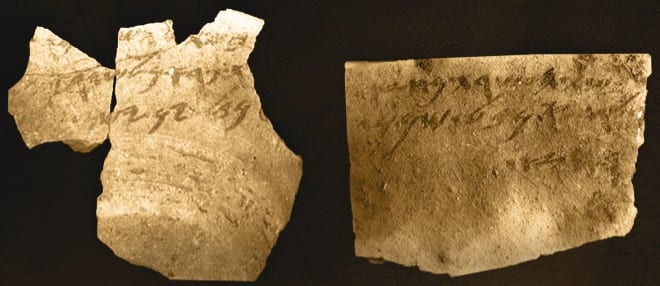Just two Jews living in the city of Samaria in the 8th Century BCE wrote 31 ink-on-clay inscriptions – called ostraca – listing shipment details of oil and wine supplied to the area, according to Tel Aviv University (TAU) archeologists.
Their discovery, which shines light on the bureaucratic apparatus and logistical infrastructure of ancient kingdom of Israel, was just published in the prestigious open-access journal PLoS ONE (Public [US] Library of Science One. It was entitled “Algorithmic handwriting analysis of the Samaria inscriptions illuminates bureaucratic apparatus in biblical Israel.”
The two writers were responsible for composing almost a third of the more than 100 inscriptions and were contemporaneous, indicating that the inscriptions were written in the city of Samaria itself. The repetitive lists of shipment details to Samaria span at least seven years.
The ancient Samaria ostraca, unearthed at the beginning of the 20th century in Samaria, are among the earliest collections of ancient Hebrew writings ever discovered. But despite a century of research, archeologists had continued to argue about their precise geographical origins — either Samaria or its outlying villages — and the number of scribes involved in their composition. Now these matters have been settled.
Research for the study was conducted by doctoral candidate Shira Faigenbaum-Golovin, Dr. Arie Shaus, Dr. Barak Sober and Prof. Eli Turkel, all of TAU’s School of Mathematical Sciences; Prof. Eli Piasetzky of TAU’s School of Physics; and TAU archeology Prof. Israel Finkelstein who specializes in the Bronze and Iron Ages.
The inscriptions feature the date of composition (year of a given monarch), commodity type (oil, wine), name of a person, name of a clan and name of a village near the capital. Based on letter-shape considerations, the ostraca have been dated to the first half of the eighth century BCE, possibly during the reign of King Jeroboam II of Israel.
“If only two scribes wrote the examined Samaria texts contemporaneously and both were located in Samaria rather than in the countryside, this would indicate a palace bureaucracy at the peak of the kingdom of Israel’s prosperity,” Finkelstein declared.
The question of literacy in ancient (biblical) Israel is crucial for biblical exegesis and related fields “Our results, accompanied by other pieces of evidence, seem also to indicate a limited dispersion of literacy in Israel in the early eighth century BCE,” Piasetzky added.
“Our interdisciplinary team harnessed a novel algorithm – consisting of image processing and newly developed machine learning techniques –
to conclude that two writers wrote the 31 examined texts, with a confidence interval of 95%,” said Sober, now is a member of Duke University’s mathematics department.
“The innovative technique can be used in other cases, both in the Land of Israel and beyond. Our innovative tool enables handwriting comparison and can establish the number of authors in a given corpus,” noted Faigenbaum-Golovin.
The new research follows up from the findings of the group’s 2016 study, which indicated widespread literacy in the kingdom of Judah a century and a half to two centuries later, about 600 BCE. For that study, the group developed a novel algorithm with which they estimated the minimal number of writers involved in composing ostraca unearthed at the desert fortress of Arad. That investigation concluded that at least six writers composed the 18 inscriptions that were examined. The researchers now intend to use their methodology to study other corpora of inscriptions from various periods and locations.
“It seems that during these two centuries that passed between the composition of the Samaria and the Arad corpora, there was an increase in literacy rates within the population of the Hebrew kingdoms,” Shaus said. “Our previous research paved the way for the current study. We enhanced our previously developed methodology, which sought the minimum number of writers, and introduced new statistical tools to establish a high-likelihood estimate for the number of hands in a corpus.”



